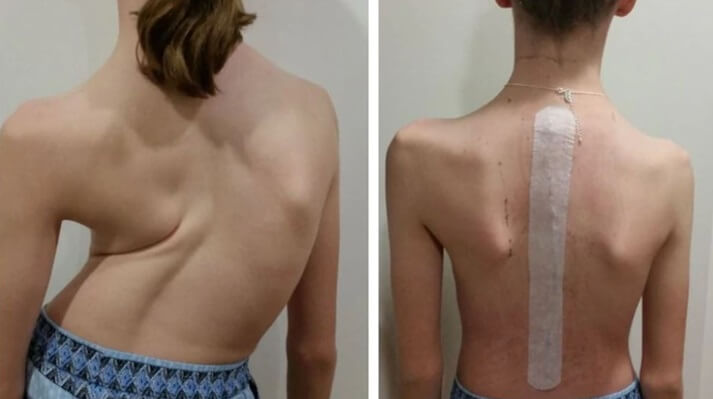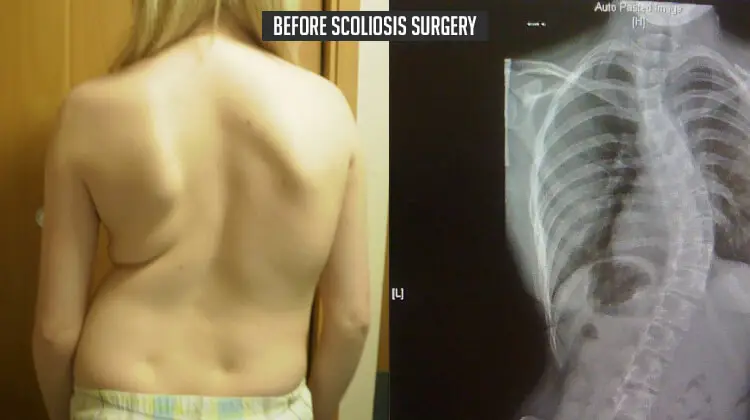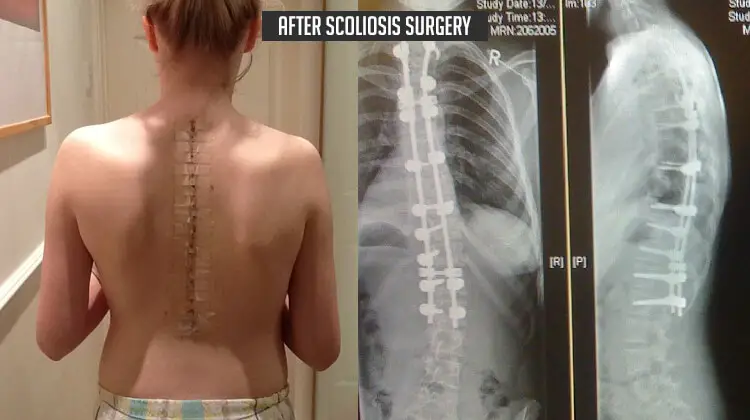Are you worried about your scoliosis surgery? Do you wonder how your surgery will turn out? And how will your life change before and after the scoliosis surgery?
Don’t worry! Remember one thing, most people have positive results out of surgery. In fact, scoliosis itself is not a deadly disorder either.
Did you know about 3% of teenagers develop scoliosis in their lifetime? And these patients have to take proper care of the back before getting surgery.
Scoliosis Surgery Before And After

What is scoliosis and why does It need surgery anyway?
Scoliosis is the abnormal bending of the back occurring mostly just before puberty. And your doctor will rule out scoliosis if your back has a more than 10-degree curve on X-ray.
If not treated, it worsens as the child grows. That is why the sooner you get the surgery the better!
About 80% of the time the cause of scoliosis is not known.
However, in many patients, it can arise later in life due to age-related degeneration of the spinal disc. Or in infants, as a result of hereditary disorder.
Before Scoliosis Surgery

Scoliosis patients have uneven shoulders, hips, and waist. Plus the shoulder blades are very prominent before the scoliosis surgery. Besides, the defective spine will block the normal airway resulting in decreased ventilation.
Don’t worry, all of this completely disappears after the surgery!
Furthermore, the curve is very much visible. Hence, you can assume the person has scoliosis simply by looking at his back. However, an X-ray is done to confirm the diagnosis of scoliosis.
The first thing to do is to consult a doctor. Your doctor will first ask you to bend a little so that he can see the S-shape curve in the spine before advising an X-ray.
He will then tell you the time of surgery and what to avoid days before the surgery.
For example, you might not be allowed to do the heavy lifting and anything that puts too much strain on your back. Plus, you will also see a change in your normal gait.
Note: There are no limitations on bending or lifting, but you might injure the back during lifting which will then worsen the condition. So, the doctor will tell you to avoid strenuous exercises.
Also, the massive change in life in the early years makes the children anxious and they often fall into depression for not being able to take part in activities like other kids of their age. The parents have to watch out for that as well.
Some patients are hospitalized and the nurses monitor their health and prepare them for surgery.
So don’t worry if your doctor asks you to stay in the hospital hours or days before scoliosis surgery. Know that it’s normal.
Commonest Complaints Before Scoliosis Surgery
The most common complaints before scoliosis surgery are:
- Back stiffness
- Constant low back pain
- Numbness due to compressed nerves from any underlying condition.
- Weakness and fatigue
After Scoliosis Surgery

After the surgery, you will again be hospitalized for a few days to weeks depending on your situation. Logrolling will become your new way to lie down and stand up from the bed for two to three days maximum.
Note: You should have a physical therapist at all times to help you take your first steps after the surgery and keep you physically active.
Six to eight weeks after the surgery
The first six to eight weeks are very important. You have to be extra cautious at this time. It’s better if you call help for cooking, lifting, bathing, or even for simple movements like standing or sitting.
Try walking around the house for as long as you can without getting tired. And most importantly, wear light and easy clothes. Remember, your comfort should be your priority!
Speaking of which, make sure your back has comfortable movements. If it gets uncomfortable at any point, try changing positions or rest for a while.
Know that it is normal to experience pain in the first few days as your bone is still fusing and will take time to start working well again. Just avoid excessive bending, lifting, or twisting.
Furthermore, here is some bad news, you won’t be allowed to drive till you have spent eight weeks of recovery. Even for you, it will get difficult to sit for long hours.
Eight weeks later
After eight weeks of surgery, most people start getting better. However, it varies from person to person.
But generally, you will not feel any pain. And the best part is, you will be independent to do your chores and start lifting small objects. Plus, you can climb stairs, go jogging, and drive for smaller distances (if it isn’t painful).
Most importantly, this is the time for a follow-up appointment. So, your doctor would tell you what to do next.
Most likely, you can’t play sports that put a strain on your back or involve excessive jumping. For example, squash, horse riding, or any sports that have a risk of causing low back injury will be banned for a year.
However, you can continue playing easy and low-risk sports three to six months after surgery, that too if your doctor allows.
Many people resume working four to six weeks later wearing a brace to support and protect the spine. However, again it depends on your condition and the recovery period does not necessarily be similar for everyone.
However, three to six months later almost everyone starts going back to work. And after 12 months, most people come back to the usual routine. But you still have to wear a brace to keep your spine stable at all times.
FAQs
Scoliosis surgery takes up to 12 months for a full recovery. However, you can start moving your back in a day or two to help stabilize the spine.
Most complications after the scoliosis surgery arise due to a failed surgery. Either the hardware breaks or the bones fail to fuse. As a result, you will feel consistent pain and the posture will show no improvement, rather it will keep getting worse.
Conclusion
In short, there is a huge change in the spine before and after scoliosis surgery. The pain is common in both the phases for which you will be discharged with pain medications.
Plus, the first few days require rest then gradually when you start feeling better your spine will start moving like before. And there won’t be any pain or resistance.
